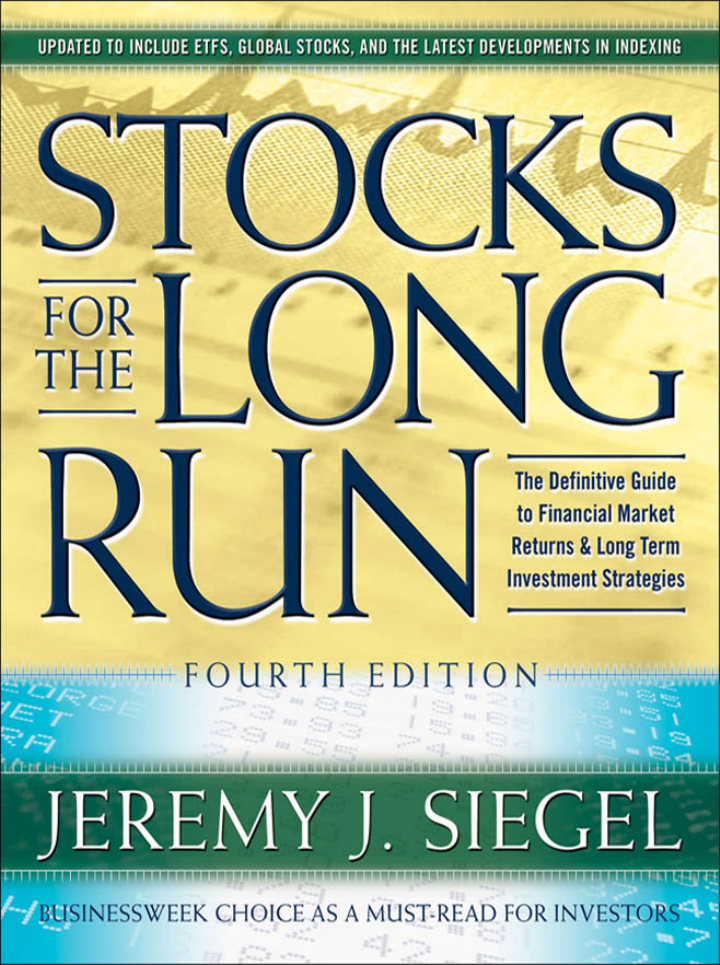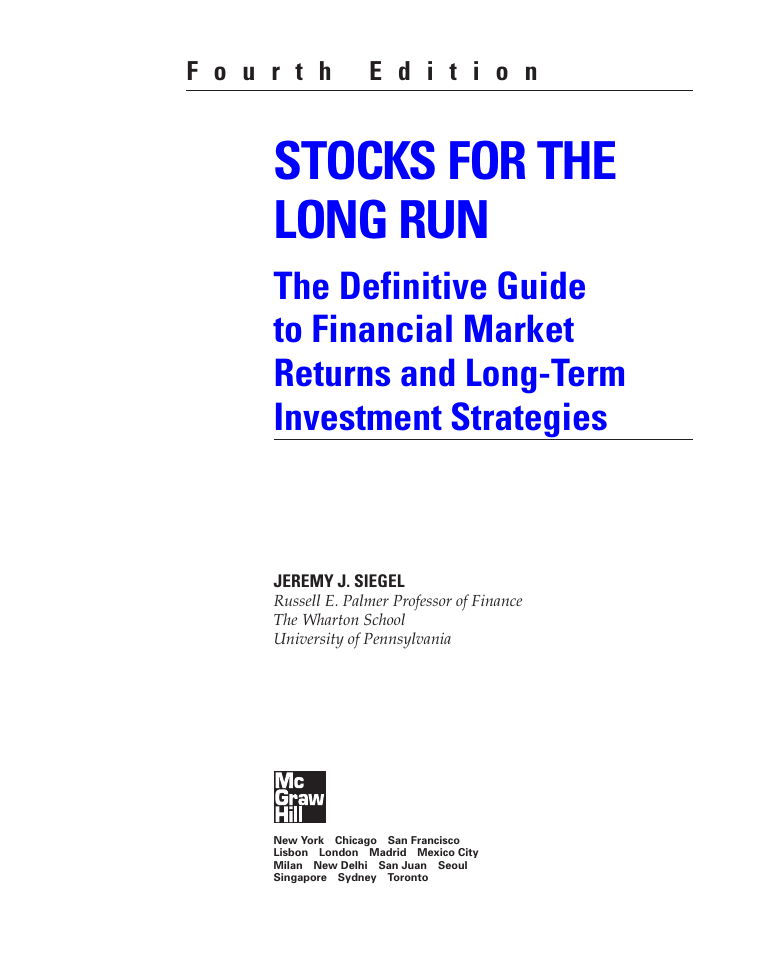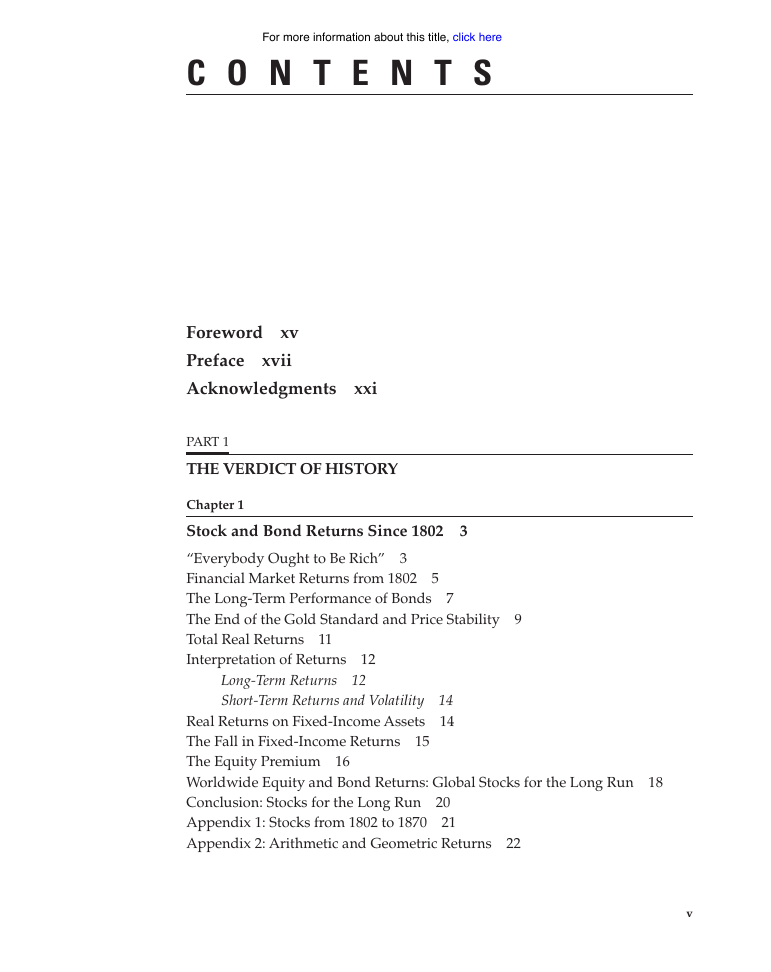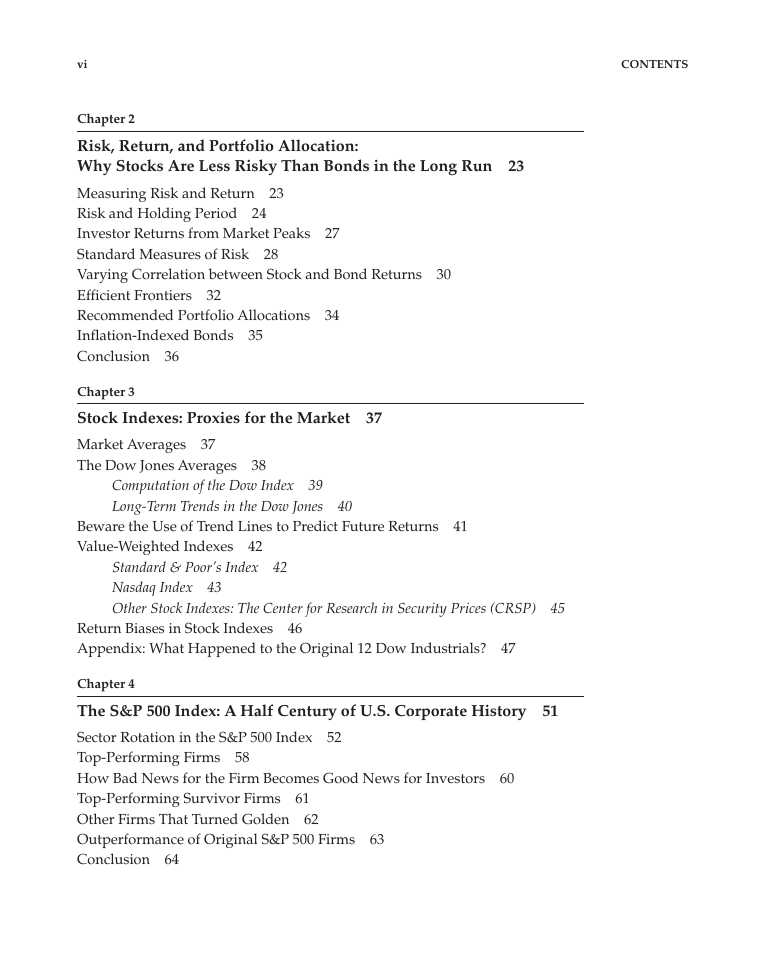Contents
Foreword
Preface
Acknowledgments
Part 1 The Verdict of History
Chapter 1 Stock and Bond Returns Since 1802
“Everybody Ought to Be Rich”
Financial Market Returns from 1802
The Long-Term Performance of Bonds
The End of the Gold Standard and Price Stability
Total Real Returns
Interpretation of Returns
Real Returns on Fixed-Income Assets
The Fall in Fixed-Income Returns
The Equity Premium
Worldwide Equity and Bond Returns: Global Stocks for the Long Run
Conclusion: Stocks for the Long Run
Appendix 1: Stocks from 1802 to 1870
Appendix 2: Arithmetic and Geometric Returns
Chapter 2 Risk, Return, and Portfolio Allocation: Why Stocks Are Less Risky Than Bonds in the Long Run
Measuring Risk and Return
Risk and Holding Period
Investor Returns from Market Peaks
Standard Measures of Risk
Varying Correlation between Stock and Bond Returns
Efficient Frontiers
Recommended Portfolio Allocations
Inflation-Indexed Bonds
Conclusion
Chapter 3 Stock Indexes: Proxies for the Market
Market Averages
The Dow Jones Averages
Beware the Use of Trend Lines to Predict Future Returns
Value-Weighted Indexes
Return Biases in Stock Indexes
Appendix: What Happened to the Original 12 Dow Industrials?
Chapter 4 The S&P 500 Index: A Half Century of U.S. Corporate History
Sector Rotation in the S&P 500 Index
Top-Performing Firms
How Bad News for the Firm Becomes Good News for Investors
Top-Performing Survivor Firms
Other Firms That Turned Golden
Outperformance of Original S&P 500 Firms
Conclusion
Chapter 5 The Impact of Taxes on Stock and Bond Returns: Stocks Have the Edge
Historical Taxes on Income and Capital Gains
A Total After-Tax Returns Index
The Benefits of Deferring Capital Gains Taxes
Inflation and the Capital Gains Tax
Increasingly Favorable Tax Factors for Equities
Stocks or Bonds in Tax-Deferred Accounts?
Conclusion
Appendix: History of the Tax Code
Chapter 6 The Investment View of Stocks: How Fickle Markets Overwhelm Historical Facts
Early Views of Stock Investing
A Radical Shift in Sentiment
The Postcrash View of Stock Returns
The Beginning of the Great Bull Market
Warnings of Overspeculation
The Top of the Bubble
The Bear Market and Its Aftermath
Part 2 Valuation, Style Investing, and Global Markets
Chapter 7 Stocks: Sources and Measures of Market Value
An Evil Omen Returns
Valuation of Cash Flows from Stocks
Earnings Concepts
Earnings Quality
Downward Biases in Earnings
Historical Yardsticks for Valuing the Market
Conclusion
Chapter 8 The Impact of Economic Growth on Market Valuation and the Coming Age Wave
GDP Growth and Stock Returns
Economic Growth and Stock Returns
Factors That Raise Valuation Ratios
The Age Wage
Conclusion
Chapter 9 Outperforming the Market: The Importance of Size, Dividend Yields, and Price-to-Earnings Ratios
Stocks That Outperform the Market
Small- and Large-Cap Stocks
Valuation
Dividend Yields
Price-to-Earnings (P-E) Ratios
Price-to-Book Ratios
Combining Size and Valuation Criteria
Initial Public Offerings: The Disappointing Overall Returns on New Small-Cap Growth Companies
The Nature of Growth and Value Stocks
Explanations of Size and Valuation Effects
Conclusion
Chapter 10 Global Investing and the Rise of China, India, and the Emerging Markets
The World’s Population, Production, and Equity Capital
Cycles in Foreign Markets
Diversification in World Markets
The World in 2050
Conclusion
Appendix: The Largest Non-U.S.-Based Companies
Part 3 How the Economic Environment Impacts Stocks
Chapter 11 Gold, Monetary Policy, and Inflation
Money and Prices
The Gold Standard
The Establishment of the Federal Reserve
The Fall of the Gold Standard
Postdevaluation Monetary Policy
Postgold Monetary Policy
The Federal Reserve and Money Creation
How the Fed’s Actions Affect Interest Rates
Stocks as Hedges against Inflation
Why Stocks Fail as a Short-Term Inflation Hedge
Conclusion
Chapter 12 Stocks and the Business Cycle
Who Calls the Business Cycle?
Stock Returns around Business Cycle Turning Points
Gains through Timing the Business Cycle
How Hard Is It to Predict the Business Cycle?
Conclusion
Chapter 13 When World Events Impact Financial Markets
What Moves the Market?
Uncertainty and the Market
Democrats and Republicans
Stocks and War
Conclusion
Chapter 14 Stocks, Bonds, and the Flow of Economic Data
Economic Data and the Market
Principles of Market Reaction
Information Content of Data Releases
Economic Growth and Stock Prices
The Employment Report
The Cycle of Announcements
Inflation Reports
Impact on Financial Markets
Central Bank Policy
Conclusion
Part 4 Stock Fluctuations in the Short Run
Chapter 15 The Rise of Exchange-Traded Funds, Stock Index Futures, and Options
Exchange-Traded Funds
Stock Index Futures
Basics of the Futures Markets
Index Arbitrage
Predicting the New York Open with Globex Trading
Double and Triple Witching
Margin and Leverage
Using ETFs or Futures
Where to Put Your Indexed Investments: ETFs, Futures, or Index Mutual Funds?
Index Options
The Importance of Indexed Products
Chapter 16 Market Volatility
The Stock Market Crash of October 1987
The Causes of the October 1987 Crash
Circuit Breakers
The Nature of Market Volatility
Historical Trends of Stock Volatility
The Volatility Index (VIX)
Recent Low Volatility
The Distribution of Large Daily Changes
The Economics of Market Volatility
The Significance of Market Volatility
Chapter 17 Technical Analysis and Investing with the Trend
The Nature of Technical Analysis
Charles Dow, Technical Analyst
The Randomness of Stock Prices
Simulations of Random Stock Prices
Trending Markets and Price Reversals
Moving Averages
Momentum Investing
Conclusion
Chapter 18 Calendar Anomalies
Seasonal Anomalies
The January Effect
Large Monthly Returns
The September Effect
Other Seasonal Returns
Day-of-the-Week Effects
What’s an Investor to Do?
Chapter 19 Behavioral Finance and the Psychology of Investing
The Technology Bubble, 1999 to 2001
Behavioral Finance
Part 5 Building Wealth Through Stocks
Chapter 20 Fund Performance, Indexing, and Beating the Market
The Performance of Equity Mutual Funds
Finding Skilled Money Managers
Reasons for Underperformance of Managed Money
A Little Learning Is a Dangerous Thing
Profiting from Informed Trading
How Costs Affect Returns
The Increased Popularity of Passive Investing
The Pitfalls of Capitalization-Weighted Indexing
Fundamentally Weighted versus Capitalization-Weighted Indexation
The History of Fundamentally Weighted Indexation
Conclusion
Chapter 21 Structuring a Portfolio for Long-Term Growth
Practical Aspects of Investing
Guides to Successful Investing
Implementing the Plan and the Role of an Investment Advisor
Concluding Comment
Index
A
B
C
D
E
F
G
H
I
J
K
L
M
N
O
P
Q
R
S
T
U
V
W
Y
Z
















 2023年江西萍乡中考道德与法治真题及答案.doc
2023年江西萍乡中考道德与法治真题及答案.doc 2012年重庆南川中考生物真题及答案.doc
2012年重庆南川中考生物真题及答案.doc 2013年江西师范大学地理学综合及文艺理论基础考研真题.doc
2013年江西师范大学地理学综合及文艺理论基础考研真题.doc 2020年四川甘孜小升初语文真题及答案I卷.doc
2020年四川甘孜小升初语文真题及答案I卷.doc 2020年注册岩土工程师专业基础考试真题及答案.doc
2020年注册岩土工程师专业基础考试真题及答案.doc 2023-2024学年福建省厦门市九年级上学期数学月考试题及答案.doc
2023-2024学年福建省厦门市九年级上学期数学月考试题及答案.doc 2021-2022学年辽宁省沈阳市大东区九年级上学期语文期末试题及答案.doc
2021-2022学年辽宁省沈阳市大东区九年级上学期语文期末试题及答案.doc 2022-2023学年北京东城区初三第一学期物理期末试卷及答案.doc
2022-2023学年北京东城区初三第一学期物理期末试卷及答案.doc 2018上半年江西教师资格初中地理学科知识与教学能力真题及答案.doc
2018上半年江西教师资格初中地理学科知识与教学能力真题及答案.doc 2012年河北国家公务员申论考试真题及答案-省级.doc
2012年河北国家公务员申论考试真题及答案-省级.doc 2020-2021学年江苏省扬州市江都区邵樊片九年级上学期数学第一次质量检测试题及答案.doc
2020-2021学年江苏省扬州市江都区邵樊片九年级上学期数学第一次质量检测试题及答案.doc 2022下半年黑龙江教师资格证中学综合素质真题及答案.doc
2022下半年黑龙江教师资格证中学综合素质真题及答案.doc